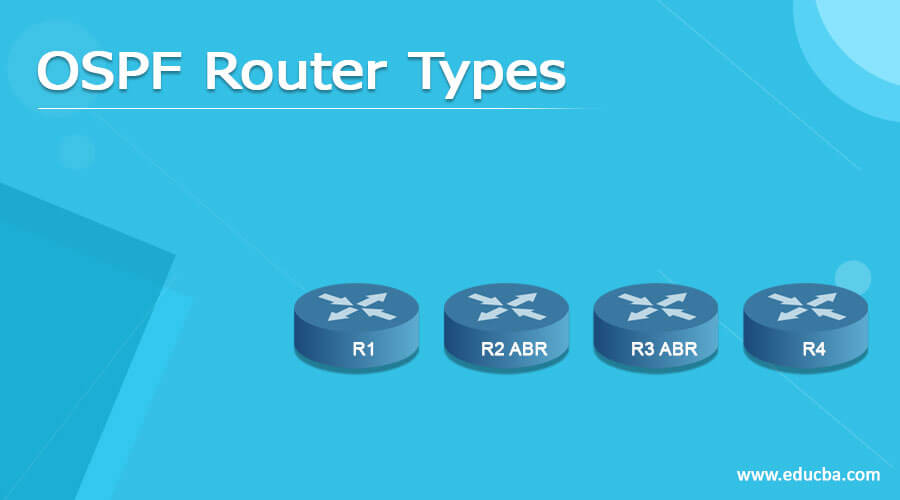Updated April 6, 2023
Definition of OSPF Router
OSPF’s hierarchical routing topology is defined by four different types of routers. Within the hierarchy, each router has a distinct role and set of distinguishing traits.
Four Types of OSPF Routers
The four types of OSPF routers are described in general in the sections below.
1. Routers for internal use: Internal routers
Internal routers are routers that belong to the same OSPF region as their directly connected networks. Because they belong to only one area, these routers have a single link-state database.
2. Area Borders Routers
Because ABRs are linked to various OSPF areas, a network can have several ABRs. Between an OSPF autonomous system and a non-OSPF network is a router. Routing information is redistributed between networks using this protocol.
Must locate in a non-stub location. Also, when OSPF reroutes traffic from other routing protocols, such as static routes, a router becomes an ASBR, and it can exist in a pure OSPF network.
3. Autonomous Systems Boundary Routers
ASBRs are connected to many ASs and communicate with routers in other ASs to exchange routing information. The transferred external routing information is advertised by ASBRs throughout their AS. Every router in an AS understands how to reach each ASBR using its AS. OSPF and other routing protocols, such as RIP or BGP, are both used by ASBRs. ASBRs must be located in an OSPF area that is not stubbed.
The redistribution command is frequently used on Cisco routers to connect two routing protocols. BGP can also be used to connect several autonomous systems. External routes are dealt with by ASBRs. The redistribute static or redistribute connected commands within the OSPF routing process is one approach to configure or activate an ASBR in OSPF.
4. Backbone Routers
Backbone routers are routers with interfaces that exclusively connect to the backbone area (BRs). Because BRs do not have an interface to the other OSPF regions, they would be considered ABRs if they did.
LSA Types in OSPF
Below are the types mentioned:
Type 1: Advertisements for router links created by each router for each area to which it belongs. Only a single region was flooded (intra-area route). Routes that originate within an area are known as Intra-Area routes by routers in the same area in a multi-area OSPF network. In the output of the “show ip route” command, these routes are marked flagged as O.
Type 2: Network link advertising are advertising published by specified routers that describe the set of routers connected to a specific network. Thousands of people flocked to the area where the network is located (intra-area route). The term “OSPF Inter-Area route” refers to a route that crosses an OSPF Area Border Router (ABR). In the output of the “show ip route” command, these routes are marked as O IA.
Type 3/4: ABR-generated summary link advertising describing inter-area routes. Type 3 describes network pathways and is used to summarise data. Type 3 is also the “default-information-originate.” Routes to the ASBR are classified as Type 4 routes (interarea summary route).
Type 5: Created by the ASBR, this type describes external interconnections to the Autonomous System (AS). These are the routes that have been redistributed (from other routing protocols, such as static routes). All places except stub areas were flooded (external route). External Type-2 or External Type-1 routes are those that were redistributed into OSPF from another routing protocol, such as Connected, Static, or another Routing Protocol.
Type 6: Multicast OSPF routers generate group membership link entries.
Type 7: ASBR generates NSSA external routes. The NSSA was the only place where people flocked. LSAs of type 7 are external routes injected internally by ASBRs within each POP (areas other than Area 0). From each POP/Area to Area 0, the ABR will convert LASs type 7 to LSAs type 5. (external route). The routes are known as NSSA external type 2 or NSSA external type 1 when an area is set as a Not-So-Stub Area (NSSA), and routes are redistributed into OSPF. In the output of the “how IP route” command, these routes are marked as O N2 or O N1.
Route Types in OSPF
OSPF routes come in a variety of shapes and sizes:
Intra-Area: In a multiarea OSPF network, routes that originate within an area are known as Intra-Area routes by routers in the same area. In the result of the show IP route command, these routes are marked as O.
Inter-Area: An OSPF Inter-Area route is one that passes via an OSPF Area Border Router (ABR). In the output of the show IP route command, these routes are marked as O IA.
Because OSPF generates Intra and Inter-Area routes when an interface is covered with the OSPF network command, they are also known as OSPF Internal routes.
External Routes: External Type-1 and External Type-2 are the two types of external routes. The difference between the two is in the method of calculating the route’s cost (metric). A Type-2 route’s cost is always the external cost, regardless of how much it costs to get there. A Type-1 cost is the sum of the external and internal costs incurred to achieve that destination. The default is External Type-2.
NSSA external type 2 or NSSA external type 1: When a Not-So-Stub Area (NSSA) is configured, and routes are redistributed into OSPF, the routes are referred to as NSSA external type 2 or NSSA external type 1. In the show IP route command output, these routes are marked as O N2 or O N1.
Conclusion
In this article, we have seen OSPF router types in detail. We hope you will find this article helpful.
Recommended Articles
This is a guide to OSPF Router Types. Here we discuss the Introduction, Four Types of OSPF Routers, and LSA Types in OSPF. You may also have a look at the following articles to learn more –


